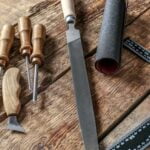Introduction
Stripping paint from woodwork is a great way to give your wooden furniture and fixtures a new look. Stripping the paint allows you to get back to the natural view of the wood, while revealing any imperfections or damages that might be hidden away under layers of paint. In addition, stripping away an old layer of paint can also help protect the wood from further decay or damage, ensuring that it will last longer and stay in better condition.
The process of stripping paint from woodwork requires some time and effort. You need to pick out a good chemical stripper that can get rid of all the layers without discoloring the wood beneath. Additionally, you need to be aware that different types of wood may require different treatments and products for proper stripping. Finally, you will need a good quality brush and/or pad for scrubbing off each layer of paint one by one until you are left with clean, unveiled wood.
The benefits of stripping paint from your woodwork extend beyond just making your fixtures look new again. By removing all traces of paint from your surfaces, you are taking proactive steps to maintain the health and longevity of the wood beneath. Also, restoring aged distressed pieces expands functional real estate in your home; antique cabinetry with fresh stains or paints often match more modern palettes than older finishes do.
What You Will Need
Stripping paint from woodwork requires a few specialized tools and materials, all of which are readily available at your local hardware store.
Materials:
● Paint stripper ” Look for brands that are specifically formulated to be safe and effective on wood, such as Citristrip Ultimate Stripper (available at Home Depot) or Peel Away 7 Heavy Duty Paint Remover (available at Lowe’s).
● Wooden scraper ” You can get either a flat-bladed or chisel-ended scraper depending on the size and texture of your surface. For example, 3M Scotch-Brite Woodworking Scrapers are great for larger surfaces with thick layers of paint. Make sure to wear protective gloves when using the scraper.
● Sandpaper or sanding block ” Start out with 80 to 100 grit sandpaper and work up from there to remove any paint residue that remain after scraping. You can go up to 3000 grit if you want an ultra-smooth finish.
Tools:
● Paintbrushes ” To help you apply the paint stripper evenly across the woodwork, use a brush with soft bristles, such as Purdy White Bristle Brushes (available in various widths).
● Safety glasses/goggles ” Always wear safety glasses or goggles whenever using chemical strippers; it will protect your eyes from harsh chemical fumes and splashes that could irritate or damage them.
● Gloves ” Wearing heavy duty rubber gloves will help keep your hands protected from chemicals while you are doing the job.
Safety Precautions
Safety precautions for stripping paint from woodwork include wearing protective clothing, including goggles and a respirator. Additionally, use gloves to protect your hands from any possible splinters when sanding down the wood. Make sure that there is proper ventilation in the room and limit the amount of time you are working with the chemicals used in stripping paint. Keep a window or door open while working and keep the area surrounding your workspace clean by sweeping up any debris.
In case of an accident, be sure to recognize any signs of contamination such as skin rashes or eye irritation. Use a mild soap solution to wash away any chemical residue that may have come in contact with your skin or eyes. Seek medical attention if irritation persists. In addition, always read product labels carefully before use and have a fire extinguisher on hand in case of emergency.
Preparing the Woodwork
Preparing the woodwork for paint stripping is a critical first step to ensure a long-lasting and attractive finish. If you are working with wood that already has paint on it, it will need to be carefully sanded before any stripping work can begin. This helps to remove any buildup of old paint or varnish, as well as create an even surface for the new paint. Depending on the type of paint used previously, you may need an appropriate chemical stripper specifically designed to effectively remove it without damaging the wood itself.
Special considerations should also be made when preparing different types of woods for stripping and painting. Hardwoods such as oak or maple can often be stripped chemically with relative ease; however softwoods like pine or cedar must be treated more delicately due to their softer nature. It may be helpful to use a chemical-free method such as sanding instead, in order to avoid any potential damage that could occur by using stronger solvents. Additionally, metal surfaces should always be sanded prior to painting in order to ensure an even finish and prevent potentially hazardous sparks from occurring if chemicals are used later in the process.
Applying Chemical Stripper
Applying Chemical Stripper:
Chemical strippers are a common and effective method for removing paint from woodwork. Before beginning to strip the paint, it is important to make sure that an appropriate chemical such as methylene chloride, caustic soda or xylene is chosen for the job. The surfaces should also be sealed off with masking tape to avoid drips running onto unwanted areas. Once ready to begin stripping, use a scraper, putty knife or drill-mounted wire brush attachment to apply the chemical stripper in even strokes. It is usually a good idea to begin at the top of an object so that any dripping can be more easily managed. When enough time has elapsed (amount of time required depends on type of goods and type of paint but usually ranges from 10 minutes – 24 hours), use a different scraper or brush tool and scrape away unsightly dried paint residue in small sections and discard them accordingly into a waste bucket.
Techniques for Optimizing Stripping Efficiency:
In order to ensure optimal stripping efficiency, one should gauge the amount of chemical stripper being applied, as too much could require more scraping than necessary and over-applying can add hours on end to total progress time. Also keep in mind not to allow the substance dry on surfaces fully before re-applying once more between sequences which will help with avoiding any gritty residues from forming onto materials afterwards; lastly when it comes time for removing certain objects (such as drawer frames) offsite in order to work on them separately, plan ahead and measure accurately that way they will fit without any hiccups after re-installation.
Removing the Stripper and Paint
Removing the Stripper and Paint:
1. Use a plastic putty knife to carefully scrape away any chipped or lifted paint.
2. Remove the remaining chemical stripper using a damp cloth, working in long strokes.
3. Change direction in your strokes to make sure no traces of stripper are left on the surface of the woodwork.
4. If needed, use a diluted solution of dishwashing detergent to further clean away any remaining traces of chemical stripper from the woodwork surface.
5. Finally, use a dry cloth to absorb all moisture from the floor, walls, and windowsills that have been coated with the chemical stripper and rinse off any residue with clean water.
Post-Removal Clean-up:
1. Rinse down all surfaces with a damp cloth saturated with clean water; this will ensure that all traces of chemicals are removed from your woodwork surfaces.
2. Dry thoroughly with a lint-free cloth or towel; this will help keep dust particles free from your newly stripped woodwork surfaces for future maintenance steps such as painting or staining if desired.
3. Inspect the surface for signs of damage from stripping and repair them by sanding accordingly if needed prior to refinishing your woodwork surfaces with paints or stains as desired.
Finishing Touches
One of the most effective and attractive methods of stripping paint from woodwork is to use a chemical stripper. Chemical strippers are available in liquid or gel form and should be applied according to their instructions. Generally, they will soften the paint so it can be scraped away with a putty knife, steel wool, or steel brush; though the last two may leave visible brush marks. Once all of the paint has been removed, sanding may be necessary for a clean and professional finish.
After sanding, it’s important to wipe off any dust particles with either a damp rag or tack cloth. This will ensure a smooth surface for applying your desired finish. Now you can decide if you want to apply a clear finish, such as lacquer or varnish, or stain the woodwork before sealing (in either case, make sure to properly stir your chosen product). If you’re staining raw wood that has never been sealed before, it would also be beneficial to apply a pre-stain wood conditioner first in order to evenly absorb the stain color. After both staining and sealing take place, use fine grit sandpaper and then wipe down with a damp rag once again before applying another layer of clear coat (if desired), before finally buffing out the finished product with 0000 steel wool.
Conclusion
The stripping of paint from woodwork is a lengthy, but rewarding process. To begin, it is essential to safety measure against dust particles by wearing protective gloves, goggles, and a respirator. It is also important to use sharp tools such as scrapers and wire brushes to remove any old coatings or layers of paint on the wood surface. Solvents can then be used to dissolve layers of paint or varnish that are difficult to remove otherwise. After all the paints have been removed, additional cleaning may be needed before applying a new finish.
Now that you have gone through this process step-by-step, you should feel confident enough to take on other DIY woodworking projects. Thanks for joining us on this journey and remember: stay safe, stay sensible!

Hi everyone! I’m a woodworker and blogger, and this is my woodworking blog. In my blog, I share tips and tricks for woodworkers of all skill levels, as well as project ideas that you can try yourself.





